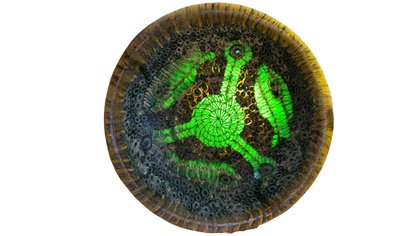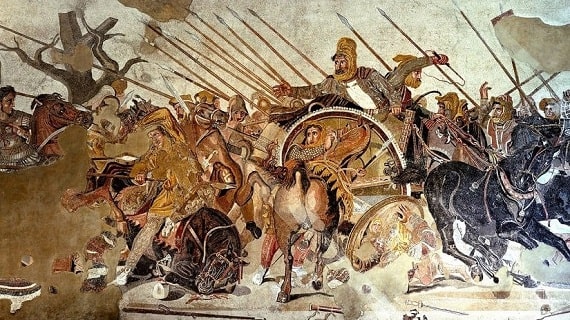Orta Doğu'da Rover UC ile birlikte Fenike cam mozaik kasesi bulundu

Dedektör
OKM Rover UC
Derinlik: 2.0 m (6.6 ft)
Bölge: Syria
Boyut: 14.5 cm x 4.5 cm | 5.7" x 1.8" (DxH)
Ağırlık: 145 g | 5.1 oz
Rover UC ile Doğu Akdeniz'de hazine avı
Sunulan hazineyi bulan kişi genellikle metal dedektörü Rover UC ile Suriye'nin güneyinde, Osmanlı İmparatorluğu döneminden kalma çok sayıda altın hazinesinden şüphelenilen bir bölgede seyahat eder. Hafif ve göze çarpmayan metal dedektörü Rover UC, ölçülen verilerin ilk değerlendirmesi için yalnızca bir akıllı telefon gerektiğinden, engebeli arazide de hazine avına izin verir. Çok fazla hazırlık gerektirmeyen metal dedektörü hemen kullanıma hazırdır ve sadece metalleri tespit etmekle kalmaz, aynı zamanda ferromanyetik ve ferromanyetik olmayan metalleri de ayırt eder. Rover UC, Orta Doğu'da hazine avı yaparken umulan altın yataklarıyla karşılaşmak yerine bir oyuk tespit etti: Antik bir tapınak kalıntısında 2 m derinlikte gizli bir mezar odası bulundu. Hazine avcısı, keşfinin altından yapılmamış değerli nesneleri ortaya çıkarması karşısında hayrete düştü. Rover UC, 3D zemin tarama fonksiyonu ile yeraltı mahzeninin izini sürdü ve hazine avcısını başarılı bir keşfe yönlendirdi. Rover UC Uygulamasına sahip akıllı telefon sonunda hazine bulgusunu aydınlatmak için bir ışık kaynağı haline geldi.

Antika cam mozaik kase - olağanüstü bir buluntu

Akdeniz'de cam sanatının yeniden keşfedilen kökenleri
Cam üretimi ilk olarak Mezopotamya'dan gelen zanaatkârlar tarafından Mısır'a getirilmiştir. Suriye ve Mezopotamya, MÖ 9. yüzyılda Akdeniz bölgesinde önemli cam üretim merkezleri haline gelmiştir. Helenistik dönemde, yani Büyük İskender döneminde, İskenderiye'deki Mısır cam atölyeleri yine öncü bir rol üstlendi. Cam işleme tekniği oradan nihayet Roma'ya ulaştı. Önceleri renkli, yarı saydam cam taşlarından testi ve kase gibi açık kaplar yapmak mümkündü. Mozaik tekniğiyle birlikte, sunulan hazinenin de gösterdiği gibi, karmaşık desenler yaratılmıştır. Cam iplikleri birbirine kaynaştırılarak daha fazla form ve şerit oluşturulabilir.
Fenike* ve Cam Sanatı


M.Ö. 1200 ile 900 yılları arasında zirveye ulaşan Fenike, Atlantik'e kadar tüm Akdeniz bölgesine hakim olmuş ve böylece antik çağın en büyük ticaret ve deniz gücü haline gelmiştir. Fenike antik dünyada özellikle tekstil ürünleri ve boyaları (mor), değerli metallerden yapılmış eşyaları, fildişi oymaları ve cam eşyalarıyla ünlüydü ve Yunan sanatı üzerinde önemli bir etkiye sahipti. Cam üretiminden etkilenen sanat, Roma İmparatorluğu'nun dört bir yanına yayılmış ve cam objeleri İpek Yolu üzerinden Çin'e taşımıştır.
Fenike mi, Babil mi, Helenistik mi, Roma mı?
Fenike sanatı Mezopotamya ve Mısır'ın yanı sıra Ege ve Hitit tarzı unsurları yerel form ve tekniklerle birleştirir. Sayısız etkinin izi, Fenike'nin çeşitli hükümdarlar yönetimindeki hareketli tarihine kadar sürülebilir:- M.Ö. 2500 Sümerler ve Akadların (Babil) etkisi altındaki Fenike şehir devletleri
- Mısır'ın etkisi altında MÖ 1800-1400
- MÖ 1100 Byblos (Djebeil), Arados (Arwad), Sidon (Saida), Tripoli, Tyros (Sur) ve Berytos (Beyrut) şehir devletlerinin dönüşümlü yönetim altında bağımsızlığı
- M.Ö. 900 Asurlular tarafından fetih
- MÖ 800-539 Babil İmparatorluğu ile bütünleşme
- MÖ 539-333 Pers İmparatorluğu ile bütünleşme
- MÖ 333/332 Helenistik etki (Büyük İskender döneminde) ve kademeli olarak Seleukos İmparatorluğu'na dahil olma
- MÖ 64 Roma'nın Suriye eyaletine entegrasyon
Sanatsal bir şekilde dekore edilmiş cam mozaik kasenin hangi döneme ait olduğuna karar vermek, bu hazine buluntusuna daha yakından bakabilen uzmanlara kalmış.
* Fenike, Akdeniz'in doğu kıyısında, bugün Lübnan'da büyük ölçüde doğuda Lübnan Dağları, güneyde Karmel Dağı ve kuzeyde Eleutheros Nehri (bugün Kebir) ile sınırlanan bir bölgeydi.
Get Rewarded for Your Treasure Finds
You have also made discoveries and detected amazing artifacts and would like to share them (anonymously)? We look forward to reading and publishing your success stories!


